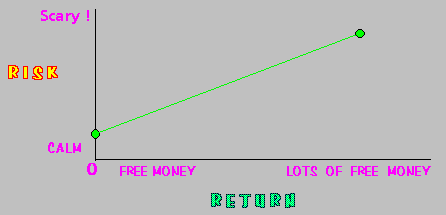
Capital Gain (or loss) + Cash Dividend / Purchase Price =
THE RETURN ON YOUR INVESTMENT
Probability = The Chance That You Get The Money
A probability is a number that describes the likelihood of "something."
Probabilities can vary from 0 to 100 percent. An investor who
examines the probability of receiving a return will see
that there are many investments with
little risk and reasonable rates of return -- like U.S. Treasury Bills.
Usually, investments that yield a higher rate of return involve more risk.
In fact, (unlike Treasury Bills) high yield investments will require that you risk your principal. That is to say: you could loose all of the money that you invest. Most people are averse to risk giving it the name, risk-aversion. For instance, when you buy a publicly traded stock, you could loose your entire investment.
On the other hand, if you didn't invest in the stock market during certain periods of history, you would have forgone huge profits. That is called profit-aversion.
To be totally risk-averse or totally risk-tolerant does not appear to be the best investment strategy. So, what we are looking for is a sane approach to risk management.
Risk
Assets having a greater
probability of loss are felt as "more risky" than those with a lesser chance of
loss. The trick is getting the greatest rate of return with the least
amount of risk.
A common approach to evaluating the risk of an asset involves estimating
the pessimistic (worst),
the most likely (expected), and the optimistic (best) return associated with a given
asset. If you take a group of investments and plot the estimated risk
against the return, it usually looks like this --

The creation of a portfolio by combining two assets that behave exactly the same way cannot reduce the portfolio's overall risk below the risk of the least risky asset. (Here comes the important part)The creation of a portfolio by combining two or more assets that behave exactly opposite can reduce the portfolio's total risk to a level below that of either asset alone -- which in certain situations may be zero.
Your well diversified portfolio will look more like this:

Here are some examples of stock portfolios.